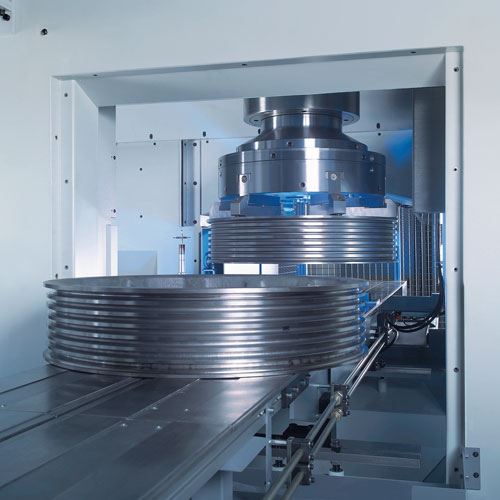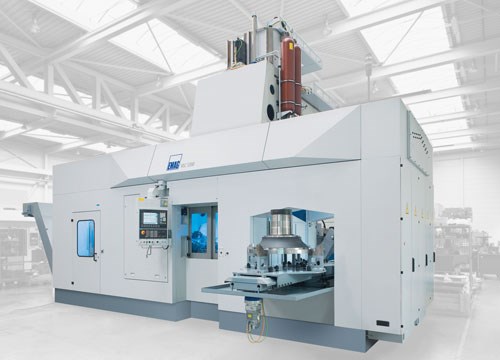Key Elements of the World’s Largest Inverted VTL
A number of noteworthy design elements enable this inverted vertical turret lathe to accurately and effectively machine very large components.
Share





Inverted vertical turret lathes (VTLs) are distinctive in that they serve as their own parts loader, using their downward-facing main spindle to pick up staged workpieces and deliver them to the machining zone. This yields a more compact footprint than other automated machining systems because no auxiliary loading equipment is needed. And because the spindle carrying the workpiece is positioned vertically above the tools, hot chips fall unhindered into a conveyor, preventing them from contaminating the machine’s main spindle or collecting upon and heating up the workpiece.
Emag’s multifunction VLC 1200 is said to be the world’s largest inverted VTL. It can pick up and machine 1,500-kg workpieces with diameters as big as 1.2 meters. Such large-part machining capability makes the VLC 1200 well-suited for manufacturing precision components used in construction machinery, industrial transmission systems and wind-turbine generating systems. Plus, the machine can perform multiple operations in a single setup, including turning, drilling, milling, grinding and gear cutting. This flexibility improves throughput while minimizing work-in-process as well as transport of big, bulky components throughout a manufacturer’s facility.
A number of noteworthy design elements enable the VLC 1200 to accurately and effectively machine very large components. Here are a few:
• Polymer-granite machine base—The VLC 1200 features a portal design with a U-shaped base made of a polymer-granite material called Mineralit. This engineered granite offers many benefits over traditional welded steel or cast iron beds. For instance, the material’s inherent stability mitigates thermal distortion traditionally observed in a steel or cast iron base. This is also why the polymer-granite material is 30 percent more effective in damping vibration compared to traditional base materials, according to the company. Less system vibration leads to better surface finishes and longer tool life while enabling aggressive cutting parameters.
• Fluid-cooling system—Although the VLC 1200’s bed is made of polymer granite, other critical assemblies have steel or cast iron frames. One example is the cast iron main spindle carrier that spans the top of the U-shaped base to create a box-frame structure with minimal component overhang. A closed-loop coolant system ensures that the spindle carrier as well as the turret, feed axes and other such components maintain a consistent temperature to ensure thermal stability.
• Powerful milling spindle with beltless drive—The machine’s milling spindle is located below the main spindle. It offers as much as 52 kW of horsepower and has an HSK A100 interface for heavy cutting applications. According to the company, a beltless-drive design eliminates backlash, feedback error and vibration to deliver quality surface finishes and precise geometries.
• On-machine part probing—A touch probe inside the machining area serves as an in-process gage to measure a workpiece still clamped in the machine to an accuracy of ±2 microns. Nominal corrections based on probe feedback are made automatically to the part program as necessary. The probe can also be used for measuring a semi-completed part feature after a tool change (before the machining operation reaches full depth). This is especially useful when machining large parts that require multiple identical tools to create a given feature.
Because the probe is mounted directly on the machine’s polymer-granite bed, its position with respect to the machine will not change due to thermal fluctuations (unlike probes installed on moving arms). A fixed probe location also offers a known home position, which simplifies machine calibration routines.
Related Content
Lean Approach to Automated Machine Tending Delivers Quicker Paths to Success
Almost any shop can automate at least some of its production, even in low-volume, high-mix applications. The key to getting started is finding the simplest solutions that fit your requirements. It helps to work with an automation partner that understands your needs.
Read MoreHow to Determine the Currently Active Work Offset Number
Determining the currently active work offset number is practical when the program zero point is changing between workpieces in a production run.
Read MoreCNC Machine Shop Honored for Automation, Machine Monitoring
From cobots to machine monitoring, this Top Shop honoree shows that machining technology is about more than the machine tool.
Read MoreInside a CNC-Machined Gothic Monastery in Wyoming
An inside look into the Carmelite Monks of Wyoming, who are combining centuries-old Gothic architectural principles with modern CNC machining to build a monastery in the mountains of Wyoming.
Read MoreRead Next
Building Out a Foundation for Student Machinists
Autodesk and Haas have teamed up to produce an introductory course for students that covers the basics of CAD, CAM and CNC while providing them with a portfolio part.
Read MoreSetting Up the Building Blocks for a Digital Factory
Woodward Inc. spent over a year developing an API to connect machines to its digital factory. Caron Engineering’s MiConnect has cut most of this process while also granting the shop greater access to machine information.
Read MoreRegistration Now Open for the Precision Machining Technology Show (PMTS) 2025
The precision machining industry’s premier event returns to Cleveland, OH, April 1-3.
Read More



















.jpg;maxWidth=300;quality=90)













